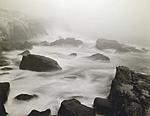My problem is the condensation which can form on my sheet film when I’m working in truly moist environments - where such moisture is often accompanied by sudden temperature changes…conditions I often encounter when I’m photographing surf.
It is the difficulty of my getting to these locations for more than a brief few days each year - plus the rarity, when on location, of actually encountering my “preferred conditions”…which themselves tend to facilitate condensation - plus the chaotic nature of my subject itself, which makes (with or without condensation) satisfactory results very “hard won” - which makes this condensation issue so very frustrating.
(Its also not too uncommon for a wave to break over me and all my gear as I’m under my dark cloth…being distracted by whatever it is I’m finding so distracting - so there is that).
At any rate…I typically carry my film (5x7 TMY in this case) in two RPT “Cascade” cases, with each cassette having been wrapped in a Ziplock bag prior to being zipped into its individual compartment. I do remove the “zippers” from the bags, as this make logistics much easier - but the bags themselves are carefully folded over the cassettes in a way that makes me doubt that (much) moisture could find its way in.
So I’m left thinking that I’m working right at some confluence of temperature and humidity which facilitates condensate forming on the film’s surface - obviously prior to making an image (can condensate which forms post-exposure cause a reduction in density? I don’t think so).
What I’m seeing on my films are either lighter (less dense) blotches with frilly edges (indicating a wiping motion and/or evaporation) or figures which look a bit like… jellyfish?, consistently shaped and relatively well defined - like what might be left after a dark slide has bowed slightly inward and outward during handling, making contact with moist film (or a moist dark slide and dry film?), leaving “water prints” on the film’s surface in the process. In fact, these “jellyfish” tend to occur away from the edges of a dark slide, more toward the middle - where such movement would be more likely to occur, while the “wiped blotches” tend to form closer to the edges, where the contact would not be so direct.
Finally…while my latest “condensation crisis” occurred while using TMY film, this issue seems somewhat less frequent/apparent when using FP-4. Would there be a reason for this?
So…any thoughts/suggestions/ideas? Thanks! Oh…and here are a couple of examples of photos which may give some indication of my “preferred working environment,” which unfortunately tends to lead to condensation:




 Reply With Quote
Reply With Quote


Bookmarks